news
Megacities Asia
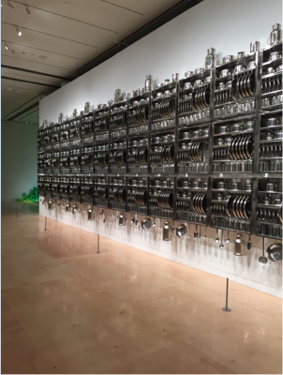
Megacities Asia
Museum of Fine Arts, Boston
April 3, 2016 – July 17, 2016
The Museum of Fine Arts, Boston’s (MFA) summer 2016 exhibition Megacities Asia invited visitors to visually immerse themselves in the frenetic pulse of five global megacities from the world’s most populous continent. A “megacity” is defined as a city whose population reaches or exceeds 10 million inhabitants. [1] Curators Laura Weinstein and Al Miner offered a vibrant sensory experience of life and artistic production from five megacities: Seoul, Mumbai, New Delhi, Shanghai and Beijing. The artists included in the exhibition draw on a diversity of materials, forms, and colors to create sculptures that play on the tensions between towering size and minute details. Despite this visual range, the exhibition organized its works into four neat thematic categories that spoke to broader issues in megacities: consumption and consumerism, modes of transportation, living spaces, and changing landscapes.
Manifestations of Self Through Art Objects
Elizabeth Gálvez, Vault Skirt: A Notion for Play, 2013. Fluorescent rip-stop nylon, steel rod, colored thread. All images property of Elizabeth Gálvez.
Vault Skirt is a piece that challenges the prescriptive society in which we live. As a child, one is encouraged to play and move freely throughout space. Yet as an adult, one can no longer simply play. Rather, the adult must engage in conventional activities, hobbies, or social interactions to have “fun.” Certain movements, especially those performed freely as a child, become accepted only in correlation to specific settings and activities. Un-restrained movement, furthermore, usually becomes unacceptable during adulthood. What becomes the adult’s outlet for the intrinsic play of childhood? Which activities return us to our most cherished experiences of pure enjoyment?
Vault Skirt seeks to transform a current tradition and social activity—dance—into one that allows for a free notion of play and movement. This work projects forward the typology of the skirt used within Mexican Baile Folklorico (Folkloric Dance). At the center of Baile Folklorico are the mesmerizing and colorful textures created by repetitive ensembles of skirts. These are the performances of twirling color and fabric that fascinated my eyes and mesmerized me into unencumbered imitations as a child. Vault Skirt reimagines a future for Baile Folklorico where the skirt becomes equipment to return us to the free movement of a child. By tweaking a simple element within the existing parameter of the original Folkloric Skirt, this work creates a vault-like enclosure to be controlled by the user. Vault Skirt allows the user to decide on the level of collectivity of the dance. As Vault Skirt falls downward, one may participate in a social dance; as one engages the vault-like structure, one is able to mask the face and play as an individual.
Elizabeth Gálvez
Doris Salcedo: The Materiality of Mourning
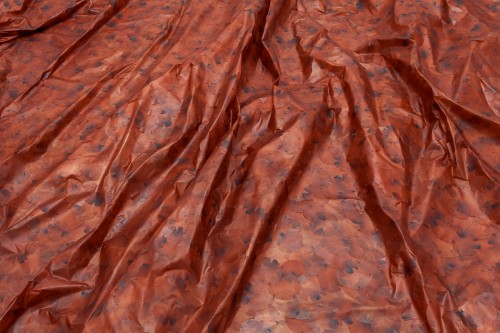
Doris Salcedo: The Materiality of Mourning
Harvard Art Museums
November 4, 2016 - April 9, 2017
Doris Salcedo: The Materiality of Mourning is a small yet focused show at the Harvard Art Museums, presenting recent sculptural works by the pioneering Colombian artist. Organized by Mary Schneider Enriques, an associate curator at the museum, the exhibition is accompanied by a major scholarly catalogue and an exciting array of public programming. Known especially for her poignant assemblages of furniture and other ordinary yet evocative materials, such as concrete and steel, Salcedo has repeatedly embraced the language of post-minimalist abstraction since the mid-1980s. In so doing, she eloquently fuses together material form and pointed social critique to offer up an aesthetics and ethics of memory and loss, as the title of this exhibition clearly implies.
Wrapped in Tin Foil: A Report from the Balkans

I relate to David Maljković’s (b. 1973 Yugoslavia, present day Croatia) characters in Scene for a New Heritage (2004-2006), a video trilogy set in the year 2045 about young men—“heritage-seekers”—on a road trip to Vojin Bakić’s 1981 Monument to the Partisans at Petrova Gora. I, too, grew up surrounded by monuments to a repudiated regime—in the Confederate capital—troubled and confused by their presence.
Rosalyn Drexler: Who Does She Think She Is?
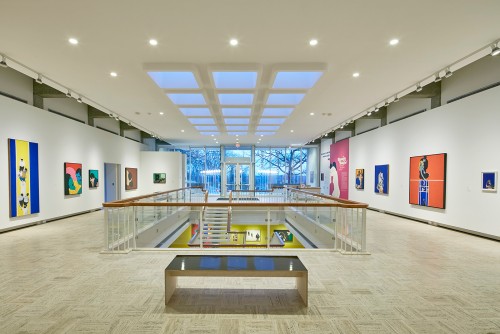
Rosalyn Drexler: Who Does She Think She Is?
Rose Art Museum, Brandeis University, Waltham, Massachusetts
February 11 - June 6, 2016
Albright Knox Art Gallery, Buffalo
October 22, 2016 - January 29, 2017
Mildred Lane Kemper Art Museum, St. Louis
February 10 - April 17, 2017
The title of the spring 2016 exhibition at Brandeis University’s Rose Art Museum poses the question, Rosalyn Drexler: Who Does She Think She Is? The answer is far from singular: the pop artist’s retrospective presents a provocative point of view informed by her intersecting identities as a painter, sculptor, author, athlete, woman and mother. Curated by Katy Siegel and Caitlin Julia Rubin, the presentation builds on recent exhibitions hosted at local universities that have similarly reevaluated the contributions of women in pop, including the Tufts University Art Gallery’s Seductive Subversion: Women Pop Artists, 1958-1968 (2011) and the Harvard Art Museums’ Corita Kent and the Language of Pop (2015). As with these shows, Brandeis presents a subjective historical glimpse into 1960s America. Yet, Drexler’s art resonates equally strongly today in its representation of a media-saturated society that is alternately sexist and sexy.
Della Robbia: Sculpting with Color in Renaissance Florence

Della Robbia: Sculpting with Color in Renaissance Florence
Museum of Fine Arts, Boston, Massachusetts
August 9, 2016 – December 4, 2016
Della Robbia: Sculpting with Color in Renaissance Florence, currently on view at the Museum of Fine Arts, Boston, celebrates the glazed terracotta technique developed by Luca della Robbia and his workshop. Though highly valued in the fifteenth and early-sixteenth centuries, and popular among American collectors in the nineteenth century, the medium has largely been overlooked by scholars and museum audiences alike. The MFA’s exhibition, the first of its kind in the United States, redresses this lacuna by introducing visitors to the expressive and accessible qualities of reliefs and free-standing figures sculpted by three generations of the Della Robbia family and rival Florentine workshops.
Beyond Bosch: The Afterlife of a Renaissance Master in Print
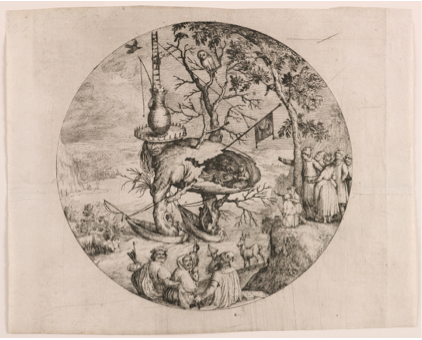
Beyond Bosch: The Afterlife of a Renaissance Master in Print
January 23, 2016 – May 8, 2016
Harvard Art Museums, Cambridge, Massachusetts
In celebration of the 500th anniversary of the death of Hieronymus Bosch (c. 1450-1516), the Harvard Art Museums present an exhibition that focuses on the development of the Netherlandish artist’s posthumous reputation. Visitors drawn in by the fame of the Bosch name might find it surprising that there is no work by the master included, but that is exactly the point of the show, which argues that it is not only by his visionary paintings that Bosch commands a reputation as one of the most fanciful, creative, and indeed hauntingly nightmarish artists of his age. Rather, this intimate exhibition is devoted to the later phenomenon of the Bosch brand, formed by the inventive Bosch-style prints, which proliferated around the mid-sixteenth century. Reinterpreting and distributing Bosch’s unique pictorial language far beyond Flanders (modern day Belgium), none of the prints are reproductions of Bosch’s paintings, yet most of the plates were inscribed with a credit to Bosch as their inventor. Then, as now, the hook was “Bosch.”
“badthingshappen…”
“badthingshappeneverydaybutnottome.com” is an ongoing web project that consists of a collaged, found-footage video and a collection of screenshots. The original footage and images are taken from Instagram humor handles and then edited to remove the funny parts of the videos. The leftover clips are reworked into a narrative, which shifts as more content is added to Instagram and the video is updated. The still images featured in the project are also taken from Instagram slapstick humor handles. Together, these images and video serve to critique complacent leisure while also considering its subversive potential.
Notes about Contributors
Steve Burges
Steve Burges is a doctoral student with a focus in Classical art and archaeology. Primarily concentrated on Roman Italy, his research interests include urbanism, cross-cultural influence, depictions of lost epics, and art historiography. He has been known to write the occasional paper on Islamic textiles or cultural heritage management.
Ewa Matyczyk
Ewa Matyczyk is a doctoral student studying Modern & Contemporary Art. Her focus is in Polish and Eastern European art and architecture of the Cold War era; particularly the 1980s and the post-socialist transition of the 1990s. Her dissertation examines artistic interventions, unrealized utopian projects, and the built environment in Warsaw as a lens through which to study the transformations of this city’s public sphere from 1970 to today.
Sophie Handler
With an academic background in French (B.A., Durham University, UK) and Art History (M.A., University of Manchester, UK), Sophie Handler chose to combine her experience and interests and pursue a Ph.D. in the History of Art at Durham University, UK. Her research focuses on concepts of childhood in the art and literature of the French Third Republic.
Janna Schoenberger
Janna Schoenberger is a Lecturer at Amsterdam University College and a doctoral candidate in art history at The Graduate Center, City University of New York. This essay was adapted from her dissertation-in-progress, Ludic Conceptualism: Art and Play in the Netherlands from 1959 to 1975.
Hyunjin Cho
Hyunjin Cho is a second-year M.A. candidate in the History of Art and Architecture Department at Boston University. She is interested in 18th and 19th century Persian/Iranian visual culture, including photographs, lithographic prints, and fashion. She has recently finished her M.A. Scholarly Paper on Iranian postage stamps issued during the reign of Nasir al-Din Shah (r. 1848-1896).
Shannon M. Lieberman
Shannon M. Lieberman is a doctoral candidate in the History of Art and Architecture at the University of California, Santa Barbara. Her dissertation, “Alongside, Outside, Within, Against: Feminist Art and the American Museum, 1965-2007,” explores the role exhibitions have played in constructing mistress narratives and definitions of feminist art.
Erin McKellar
Erin McKellar’s research focuses on the design cultures of the 1940s. Her dissertation, “Tomorrow on Display: American and British Housing Exhibitions, 1940-1955,” investigates how curators visualized, materialized and concretized abstract ideas about town planning, dwellings and home furnishings for approval and consumption by a skeptical yet curious lay public.
Joseph Saravo
Joseph Saravo is a doctoral candidate at Boston University studying seventeenth-century Dutch and Flemish art. His current research considers the intersections of vision and touch as related to the beholder’s experience in the early modern period.
Catherine O’Reilly
Catherine O’Reilly is a Ph.D. candidate at Boston University, focusing on Italian Renaissance art. Her dissertation project is entitled “Last Supper Refectory Frescoes in Fifteenth-Century Florence: Painting, Performance, Senses, and Space.” She received her M.A. in Art History from Tufts University and her B.A. in Art History from Union College.
Nicole Brunel
Nicole Brunel is a Canadian MFA student studying at the University of Illinois Urbana-Champaign. She has also worked as a touring musician, archaeologist, and comic book artist.
Emily Quinn
Emily Quinn uses stories from her life as inspiration for her narrative paintings and drawings. She grew up in Decatur, AL, received a BFA in Painting and Drawing from Auburn University in 2013 and is currently pursuing an MFA in Painting and Drawing from the University of Colorado in Boulder.
2015-2016 SEQUITUR Editorial Team
Senior Editors: Ewa Matyczyk, Steve Burges
Junior Editors: Sasha Goldman, Jordan Karney Chaim, Erin McKellar
Faculty Advisor: Professor Alice Tseng, Interim Chair of History of Art & Architecture
Special thanks to Susan Rice and Chris Spedaliere
Peacock Room REMIX: Darren Waterston’s “Filthy Lucre”
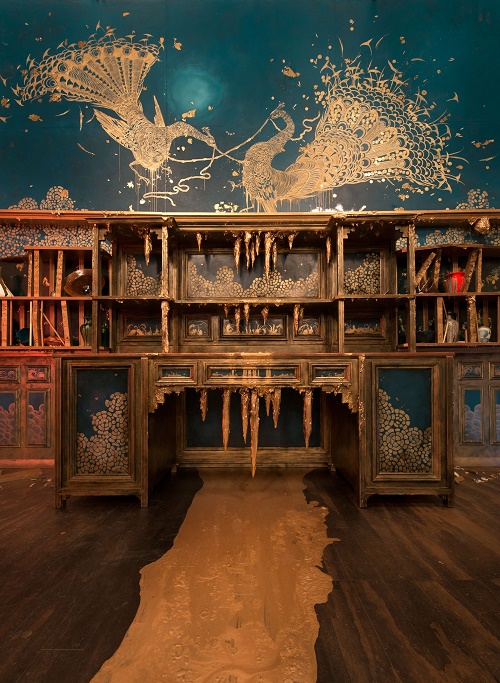
Peacock Room REMIX: Darren Waterston’s Filthy Lucre
Arthur M. Sackler Gallery, Washington, DC, through January 2017
The Peacock Room by James McNeil Whistler is composed of a full room of elaborately decorated panels that were designed for Frederick R. Leyland, a British businessman and an art collector, for his London dining room in 1876. This indoor mural reflects Whistler’s dedication to creative freedom and his strong desire to achieve aesthetic perfection. Later, Charles Lang Freer, an American collector, purchased Whistler’s Peacock Room and installed it in his own dining room in Detroit. After Freer’s death in 1919, the Peacock Room was moved to Washington D.C. where it is permanently on view at the Smithsonian’s Freer Gallery of Art.











